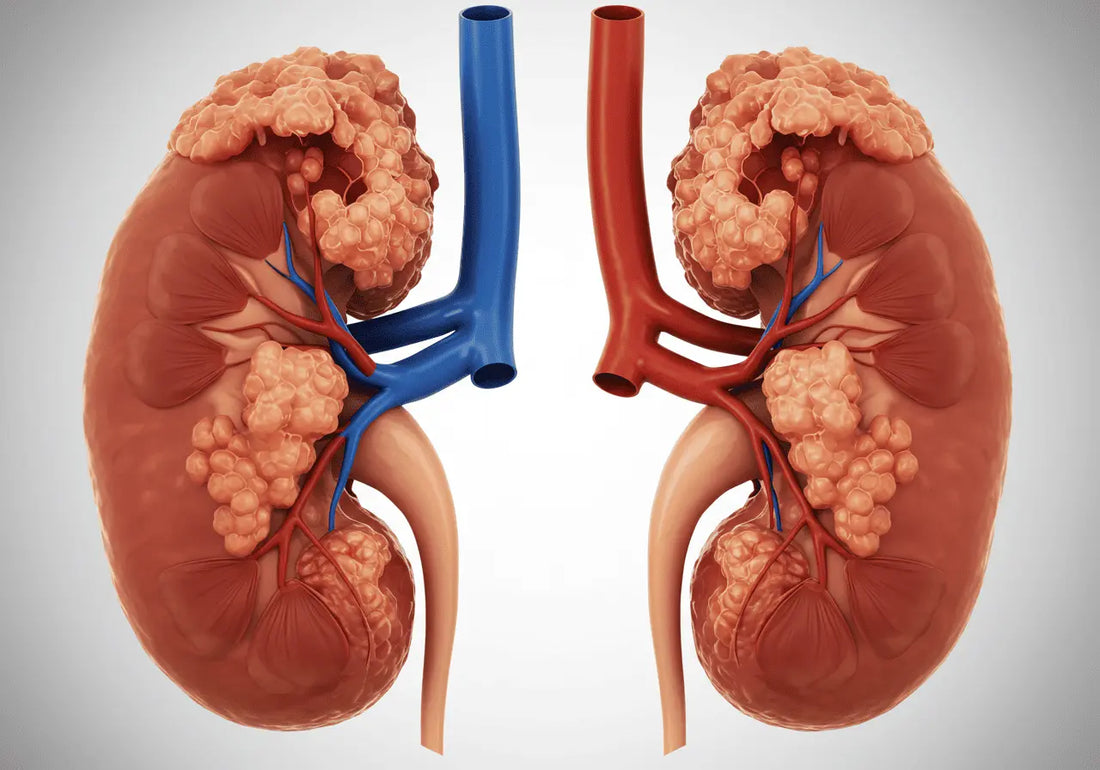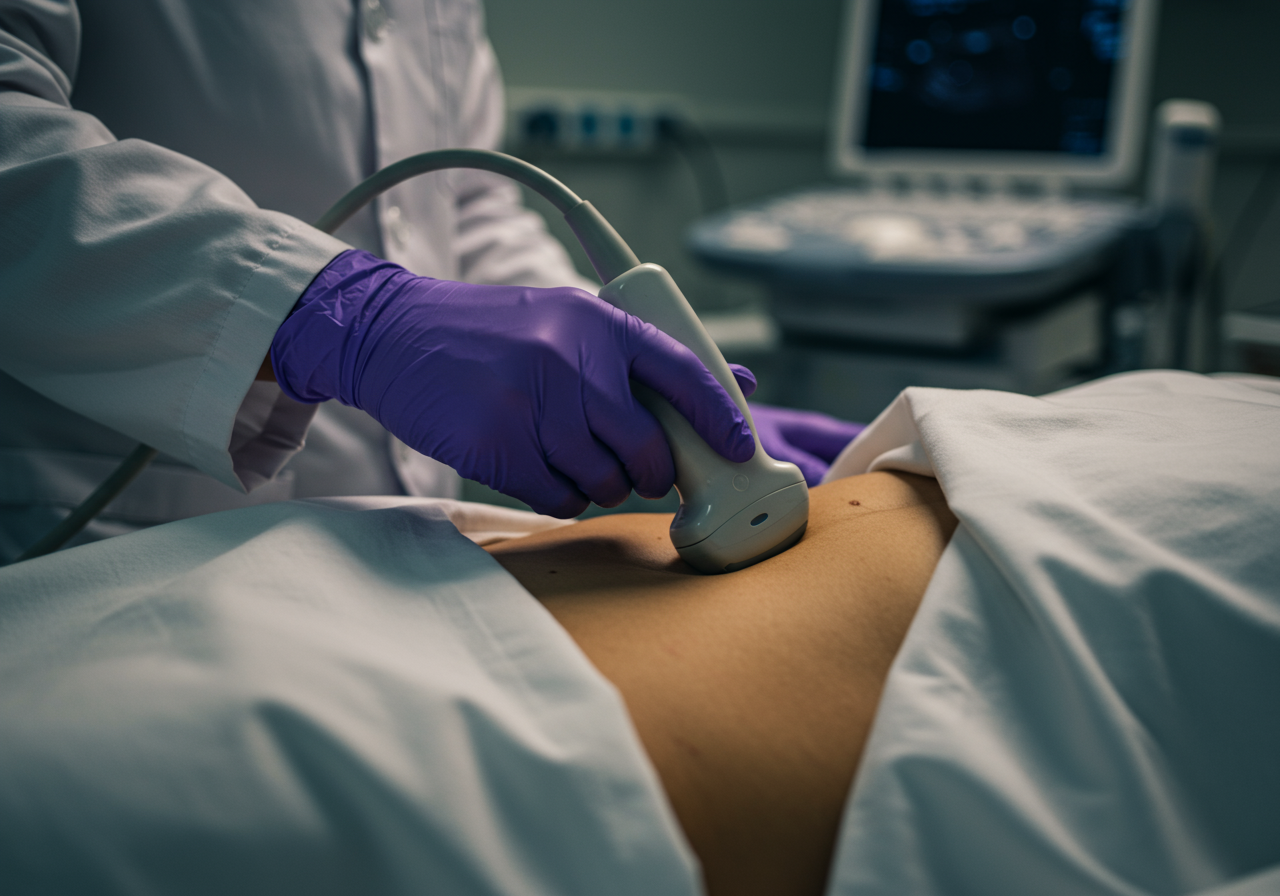What Size of Kidney Cyst Is Dangerous? How to Know When to Take Action
 Written By
Abel Tamirat, MD
Written By
Abel Tamirat, MD

If you’ve recently learned that you have a kidney cyst, you’re probably wondering what it means. You might have discovered it during a scan for something unrelated, and now you’re left with questions: Is it serious? Should you be worried? What size of kidney cyst is considered dangerous?
These are important questions—and they deserve clear, evidence-based answers. The truth is that most kidney cysts are harmless, but certain features, including size and internal structure, can signal the need for closer evaluation or treatment.
This guide will help you understand the differences between simple and complex kidney cysts, when a cyst becomes concerning, and what you can do to protect your kidney health.
Understanding Kidney Cysts
A kidney cyst is a fluid-filled sac that develops either on the surface or within the tissue of the kidney. Cysts can vary in size, ranging from a few millimeters to several centimeters. Some people develop just one, while others may have multiple cysts.
There are two main categories of kidney cysts:
Simple Cysts
-
Most common type
-
Thin, smooth outer walls
-
Filled with clear, watery fluid
-
Typically asymptomatic
-
Very low risk of turning cancerous
These are often found incidentally during imaging and usually do not require treatment unless they grow large or cause symptoms.
Complex Cysts
-
May have thickened walls, calcifications, septa (internal dividers), or solid components
-
Can be irregular in shape
-
Associated with a higher risk of malignancy
Require follow-up imaging or evaluation
Understanding the type of cyst you have is essential in determining its potential risk.
As kidney cysts grow or multiply, they may impair kidney function—potentially reflected in changes to creatinine levels, a key kidney health marker.
The Bosniak Classification System
To evaluate kidney cysts more precisely, radiologists use the Bosniak classification system. This system categorizes cysts based on their appearance on imaging studies, especially CT scans.
|
Bosniak Category |
Description |
Estimated Cancer Risk |
Recommended Action |
|
Bosniak I |
Simple cyst with thin wall and no septa or calcification |
~0% |
No treatment needed |
|
Bosniak II |
May have a few thin septa or fine calcifications |
<1% |
No treatment needed |
|
Bosniak IIF |
Requires follow-up due to more complexity (F = Follow-up) |
5–12% |
Repeat imaging every 6–12 months |
|
Bosniak III |
Thick walls, irregular septa, possible solid areas |
50–80% |
Surgical evaluation recommended |
|
Bosniak IV |
Clearly malignant features, including solid enhancing components |
>90% |
Surgical removal indicated |
The higher the Bosniak category, the greater the concern for malignancy.
Does Size Matter? What to Know About Risk and Measurements
While the structure of a cyst is often more important than its size, dimensions still play a key role in how doctors assess risk.
General Guidelines by Size
|
Cyst Size |
Clinical Concern |
Next Steps |
|
<4 cm |
Low risk |
Typically no intervention needed |
|
4–5 cm |
Mild concern |
Monitor if symptoms are present or if complex features appear |
|
5–10 cm |
Moderate risk |
Follow-up imaging or treatment may be advised |
|
>10 cm |
Higher risk |
Likely to require treatment or removal |
|
Any size, if complex |
High risk |
Evaluation based on Bosniak classification |
A cyst larger than 5 cm often draws attention because it may:
-
Press against surrounding organs
-
Obstruct the flow of urine
-
Increase the risk of rupture
-
Cause noticeable symptoms
However, a small cyst with suspicious internal features can sometimes be more concerning than a large but simple one.
Symptoms That Suggest a Problem
Most kidney cysts are asymptomatic and discovered incidentally. However, some may cause symptoms, especially if they grow large, become infected, rupture, or interfere with kidney function.
Symptoms to watch for include:
-
A dull or aching pain in the side or lower back
-
Abdominal discomfort or fullness
-
Visible blood in the urine (hematuria)
-
Difficulty urinating or reduced urine flow
-
Larger or obstructive cysts may lead to recurring urinary tract infections, which often present with pain or frequent urination.
-
Fever and chills (could indicate infection)
-
Sudden, sharp flank pain (possible cyst rupture)
Abnormalities such as visible blood or unusual urine color may be early indicators of complications related to cyst growth or rupture.
These symptoms should prompt you to consult a healthcare provider for further evaluation.
How Kidney Cysts Are Diagnosed
The diagnosis typically begins with imaging, especially if a cyst is discovered incidentally.
Imaging Techniques
-
Ultrasound: Often the first test used. It is non-invasive and doesn’t involve radiation.
-
CT Scan: Provides detailed imaging, allowing doctors to assess cyst walls, septations, calcifications, and enhancement.
-
MRI: Used when contrast CT is contraindicated or when additional detail is needed, especially for complex cysts.
These imaging techniques help classify the cyst and determine whether further steps are needed.
When Is Treatment Necessary?
Not every kidney cyst requires treatment. Most simple cysts are harmless and may never change in size or cause symptoms.
Treatment Is Usually Considered If:
-
The cyst is larger than 5–10 cm
-
You are experiencing symptoms such as pain or urinary issues
-
The cyst has complex features (Bosniak IIF, III, or IV)
-
There is suspicion of malignancy
-
The cyst has become infected or has ruptured - signs often accompanied by leukocytes in urine, a marker of inflammation.
Treatment Options for Kidney Cysts
When intervention is needed, treatment is tailored based on cyst size, location, and complexity.
1. Observation and Monitoring
-
Suitable for simple, asymptomatic cysts
-
Follow-up imaging may be scheduled every 6–12 months
-
No intervention unless the cyst grows or becomes symptomatic
2. Aspiration and Sclerotherapy
-
A needle is used to drain the fluid - A needle is used to drain the fluid, and a 24-hour urine collection may be recommended to monitor output before and after treatment.
-
A sclerosing agent (e.g., ethanol) is injected to collapse the cyst and prevent recurrence
-
Most effective for large, simple cysts that cause discomfort
3. Surgical Removal
-
Typically reserved for complex or large symptomatic cysts
-
Laparoscopic surgery is less invasive and involves quicker recovery
-
Open surgery may be necessary for very large or deeply located cysts
Complete or partial nephrectomy (removal of kidney tissue) may be performed if cancer is suspected
Can Kidney Cysts Become Cancerous?

While simple cysts are rarely malignant, complex cysts—especially Bosniak III and IV—carry a higher risk of being cancerous. That’s why structural characteristics, not just size, are so important in determining treatment.
Even in high-risk cases, early diagnosis and appropriate management often lead to good outcomes.
Lifestyle Strategies to Support Kidney Health
While you can’t always prevent kidney cysts, maintaining strong kidney function can reduce complications. These lifestyle practices support overall kidney health:
1. Stay Well Hydrated
Adequate fluid intake helps your kidneys flush out waste and toxins. Most adults benefit from drinking at least 6–8 glasses of water per day unless advised otherwise by a doctor.
Staying well hydrated can reduce kidney stress. Since dehydration may worsen cyst-related discomfort, it’s crucial to recognize signs of dehydration early.
2. Manage Blood Pressure and Blood Sugar
Uncontrolled hypertension and diabetes are leading contributors to kidney damage. Monitor levels regularly and follow your treatment plan if diagnosed with either condition.
Managing blood sugar is especially crucial for diabetic patients. Here's how to reverse kidney damage from diabetes effectively.
3. Limit Sodium and Processed Foods
Reducing sodium intake helps protect your kidneys and lowers blood pressure. Processed foods, which often contain high levels of sodium and preservatives, should be minimized.
4. Avoid Long-Term Use of NSAIDs
Over-the-counter pain relievers like ibuprofen and naproxen can be harmful to the kidneys when used excessively. Use them only when necessary and under medical supervision.
5. Maintain a Healthy Weight
Obesity increases the risk of both kidney disease and cyst development. Regular physical activity and a balanced diet can help reduce these risks.
6. Avoid Smoking and Excess Alcohol
Both tobacco and alcohol increase your risk of developing kidney and urinary tract conditions. If you smoke or drink regularly, talk to your provider about support for quitting or reducing intake.
Also, learn how alcohol may contribute to kidney stones and other renal complications.
When to See a Doctor

You should schedule a medical evaluation if you experience:
-
New or worsening pain in your back or side
-
Changes in your urination (such as blood or reduced flow)
-
Recurrent urinary tract infections
-
Unexplained fatigue, weight loss, or fever
-
A known cyst that has grown on follow-up imaging
-
Imaging results indicating Bosniak III or IV
Your doctor may recommend follow-up imaging, blood tests like creatinine or protein analysis to assess kidney function and filter capacity.
Conclusion: Not All Cysts Are Dangerous, But Some Deserve Closer Look
Kidney cysts are common and often benign. A cyst’s size is one factor doctors consider, but the structure of the cyst—and whether it causes symptoms—plays an even more critical role.
If your kidney cyst is small and simple, chances are it requires no treatment. But if it’s growing, causing discomfort, or appears complex on imaging, your healthcare provider may recommend closer monitoring or removal.
Being proactive with your health and attending follow-up appointments ensures that any changes are caught early. Most importantly, understanding the nature of your cyst helps you make informed decisions and avoid unnecessary worry.
Explore Kidney Health from Home
Ribbon Checkup offers science-backed, at-home testing tools designed to help you stay ahead of kidney concerns. Monitor your markers, track changes, and take informed action—all from home.
Related Resources
-
Understanding Creatinine Levels: A Comprehensive Guide
Discover how creatinine levels reflect kidney function and why monitoring them is essential when cysts are present. -
Urine Specific Gravity: Normal Levels & Impact on Health
Learn how this simple test can indicate whether a kidney cyst is affecting your body’s ability to concentrate urine. -
Recurring UTIs: Tests, Reasons & Treatment
Kidney cysts can sometimes block urinary flow and lead to frequent infections—understand the signs and testing options.
References
How to Keep Your Kidneys Healthy in 2024. (2024, September 25). Retrieved May 25, 2025, from National Kidney Foundation website: https://www.kidney.org/news-stories/how-to-keep-your-kidneys-healthy-2024
Kidney cysts - Diagnosis and treatment - Mayo Clinic. (2025). Retrieved May 25, 2025, from Mayoclinic.org website: https://www.mayoclinic.org/diseases-conditions/kidney-cysts/diagnosis-treatment/drc-20374138
O. Hélénon, A. Crosnier, V. Verkarre, S. Merran, A. Méjean, & J.-M. Correas. (2018). Simple and complex renal cysts in adults: Classification system for renal cystic masses. Diagnostic and Interventional Imaging, 99(4), 189–218. https://doi.org/10.1016/j.diii.2017.10.005
Silverman, S. G., Pedrosa, I., Ellis, J. H., Hindman, N. M., Schieda, N., Smith, A. D., … Davenport, M. S. (2019). Bosniak Classification of Cystic Renal Masses, Version 2019: An Update Proposal and Needs Assessment. Radiology, 292(2), 475–488. https://doi.org/10.1148/radiol.2019182646
Whelan, T. F. (2010). Guidelines on the management of renal cyst disease. Canadian Urological Association Journal, 4(2), 98–99. https://doi.org/10.5489/cuaj.10023

Dr. Abel Tamirat is a licensed General Practitioner and ECFMG-certified international medical graduate with over three years of experience supporting U.S.-based telehealth and primary care practices. As a freelance medical writer and Virtual Clinical Support Specialist, he blends frontline clinical expertise with a passion for health technology and evidence-based content. He is also a contributor to Continuing Medical Education (CME) programs.



